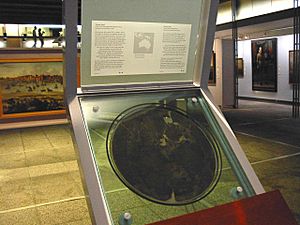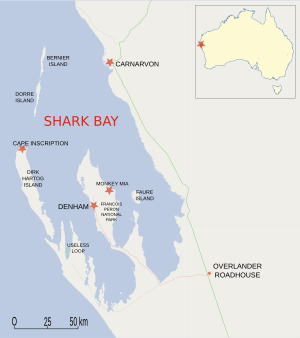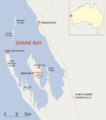Dirk Hartog facts for kids
Dirk Hartog (born 1580 – died 1621) was a famous Dutch sailor and explorer from the 1600s. His journey was the second time a European group landed in Australia. He was also the first to leave something behind to show he had visited: a special metal plate called the Hartog Plate. Sometimes his name is spelled differently, like Dirck Hartog. An island in Western Australia is named after him, called Dirk Hartog Island.
Life of a Sailor
Dirk Hartog came from a family of sailors. He became a ship's captain when he was 30 years old. For several years, he successfully traded goods across the Baltic Sea and the Mediterranean Sea.
In 1616, Hartog started working for the Dutch East India Company. This was a very powerful trading company. He became the captain of a ship called the Eendracht, which means "Concord" or "Unity." His ship was part of a fleet sailing from the Netherlands to the Dutch East Indies (which is now Indonesia).
Hartog's journey began in January 1616. His ship got separated from the others during a big storm. He arrived alone at the Cape of Good Hope in South Africa. From there, Hartog sailed across the Indian Ocean towards Batavia (today's Jakarta). He used strong westerly winds, known as the "Roaring Forties." These winds helped ships travel faster to Java.
Landing in Australia
On October 25, 1616, Hartog and his crew unexpectedly found some islands. They were at about 26 degrees south latitude. These islands were empty, with no people living on them. He landed on an island off the coast of Shark Bay, Western Australia. This island is now called Dirk Hartog Island in his honor.
His landing was the second time Europeans were known to have visited Australia. Another Dutch sailor, Willem Janszoon, had landed in 1606. But Hartog was the first to land on Australia's western coast.
Hartog spent three days exploring the coast and nearby islands. He named the area Eendrachtsland after his ship. However, this name is not used anymore. Before leaving, Hartog left a pewter plate on a post. This plate, now known as the Hartog plate, had a message scratched into it. It recorded his visit to the island.
The message on the plate said:
- 1616 On 25 October arrived the ship Eendracht, of Amsterdam: Skipper Dirch Hatichs of Amsterdam. on 27 d[itt]o. she set sail again for Bantam. In the year 1616.
Hartog did not find anything interesting. So, he continued sailing north along the unknown coast of Western Australia. He made nautical charts, which are maps for sailors. Then he left the coast and sailed to Batavia. He arrived safely in December 1616, about five months later than planned.
Dirk Hartog stopped working for the Dutch East India Company when he returned to Amsterdam in 1618. He went back to his own trading business in the Baltic Sea.
After Hartog's Visit
In 1619, two other Dutch East India Company ships sighted land near present-day Perth. They called it d'Edelsland. After sailing north, they reached Eendrachtsland.
Eighty years later, on February 4, 1697, another Dutch explorer named Willem de Vlamingh landed on Dirk Hartog Island. By chance, he found Hartog's plate, which was partly buried in the sand. He replaced it with a new plate. This new plate had Hartog's original message and de Vlamingh's own notes. De Vlamingh took Hartog's original plate back to Amsterdam. It is now kept in the Rijksmuseum.
In 2000, the Hartog plate was brought to Australia for a short time. It was part of an exhibition in Sydney. Many people thought the plate should stay in Australia. It is very important as the oldest known written item from Australia's European history. However, the Dutch authorities said the plate was not for sale.
Dirk Hartog has been honored in Australia. In 1966 and 1985, his image appeared on Australian postage stamps. In 2016, a special silver coin was made to celebrate 400 years since his landing in Australia. The island where he landed is named Dirk Hartog Island. Streets in Amsterdam, Canberra, and fourteen other Australian towns are also named after him.
See also
 In Spanish: Dirk Hartog para niños
In Spanish: Dirk Hartog para niños
Images for kids




